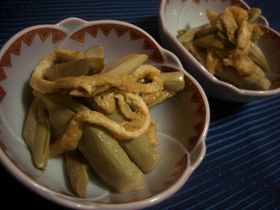The Sansai/Mountain Vegetable season has started for good in Japan and might be around the corner in many parts of the world, but many people are still wondering how to prepare and eat them.
Here is a simple explanation of how the Japanese do it with some of them.
I’ll try to research for more in the near future.
ITADORI/JAPANESE KNOTWEED
Japanese Knotweed (Fallopia japonica, syn. Polygonum cuspidatum, Reynoutria japonica) is a large, herbaceous perennial plant, native to eastern Asia in Japan, China and Korea. In North America and Europe the species is very successful and has been classified as invasive in several countries. About time to eat it, then!
Closely related species include giant knotweed (Fallopia sachalinensis, syn. Polygonum sachalinense) and Russian vine (Fallopia baldschuanica, syn. Polygonum aubertii, Polygonum baldschuanicum).
Other English names for Japanese knotweed include fleeceflower, Himalayan fleece vine, monkeyweed, Huzhang (Chinese: 虎杖; pinyin: Hǔzhàng), Hancock’s curse, elephant ears, pea shooters, donkey rhubarb (although it is not a rhubarb), sally rhubarb, Japanese bamboo, American bamboo, and Mexican bamboo (though it is not a bamboo). There are also regional names, and it is sometimes confused with sorrel.
In Japanese, the name is itadori (虎杖, イタドリ).
Japanese knotweed flowers are valued by some beekeepers as an important source of nectar for honeybees, at a time of year when little else is flowering. Japanese knotweed yields a monofloral honey, usually called bamboo honey by northeastern U.S. beekeepers, like a mild-flavored version of buckwheat honey (a related plant also in the Polygonaceae).
The young stems are edible as a spring vegetable, with a flavor similar to mild rhubarb. In some locations, semi-cultivating Japanese knotweed for food has been used as a means of controlling knotweed populations that invade sensitive wetland areas and drive out the native vegetation.
RECIPE:
Peel the knotweed from the root (easier this way). Peel all the skin!
Boil the knotweed. If you have a lot of them, proceed in batches.
Once the knotweed colour has turned from deep green to “tea green”, the boiling should be enough. It would take up to 2 minutes for items of the thickness shown on the above picture.
Note that that if the deep-green colour hasn’t sufficiently gone, the knotweed will be acid in taste.
Now as soon as you attained the right colour, scoop knotweed out or over cooking will result in the plant breaking up. Very important!
Transfer immediately into chilled water. Leave it there for a whole night and you will be able to get rid of astrigency and unwanted matters.
Next morning drain, cleanse under cold running water and drain thoroughly.
It can be preserved inside the fridge for quite some time inside a tupperware box.
If you have a lot you can always make salty pickles of them.
If you do so, just put them inside a tightly closed tupperware box with a good measure of salt. Wash them with plenty of water before consuming them.
Freshly boiled, they can be eaten as they are with mayonnaise, or a simple dressing for vegans and vegetarians. A little chili pepper is fine, too!
Simple recipe 1:
Two large knotweed (boiled and prepared as above).
Japanese sake: 1/2 tablespoon
Water: 1/2 tablespoon
Mirin/sweet Japanese sake: 1 tablespoon
Men tsuyu/vegan dashi: 1/2 tablespoon
Gently simmer the whole together for a little while.
Try and serve together with other boiled vegetables!
Simple recipe 2:
Two large knotweed (boiled and prepared as above).
Aburaage (fried tofu sheet): 1/2
Cut the aburaage into fine strips and fry them quickly with knotweeed.
Add Mirin/sweet sake (1 tablespoon), men tsuyu or vegan dashi (a little less than a tablespoon) while frying. Finish with withsome sesame oil and eat at once!
Great with beer or sake!
Uropean/American style cuisine suggestion:
Itadori/Japanese knotweeed in tomato sauce!
RECOMMENDED RELATED SITES:
Warren Bobrow, Bread + Butter, Zoy Zhang, Hungry Neko, Think Twice, Frank Fariello, Mangantayon, Hapabento, Elinluv Tidbit Corner, Tokyo Terrace, Maison de Christina, Chrys Niles,Lexi, Culinary Musings, Wheeling Gourmet, Comestiblog, Chronicles Of A Curious Cook, Bento Boutique, Tokyo Through The Drinking Glass, Tokyo Foodcast, Urban Sake, Sake World, Palate To Pen, Yellin Yakimono Gallery, Tokyo Terrace, Hilah Cooking, More than a Mount Full, Arkonite Bento
Please check the new postings at:
sake, shochu and sushi
—————————————-
日本語のブログ
—————————————-













Absolutely delicious! My grandma is 80 with cancer, and I am cooking everything that mother earth has to offer. Your menu has given her great strength and more memory. It only took me 9 years to find you. I surely hope you can wow the world again with more health benefiting meals. Thank you again from. Vermont U S A
LikeLike
Bei mir im Garten wächst das Zeug auch wie Unkraut. Gut zu wissen, dass Itadori essbar ist. Nun fehlen nur noch ein paar leckere Rezepte. Vielen Dank für diesen Artikel! 🙂
LikeLike
You are most welcome!
LikeLike
I think I may have some fallopia sachalinensis volunteers in my yard but would like to be sure before eating. Any suggestions on how I might be able to get a positive i.d.? I have tried several guide books to weeds but without much success.
Thanks!
LikeLike
Sorry, that’s how much I could do!
LikeLike
Absolutely delicious! My grandma is 80 with cancer, and I am cooking everything that mother earth has to offer. Your menu has given her great strength and more memory. It only took me 9 years to find you. I surely hope you can wow the world again with more health benefiting meals. Thank you again for Vermont U S A
LikeLike
Dear Jessica!
You are most welcome!
My sincere regards to your grandma!
Best regards from Shizuoka,
Robert-Gilles
LikeLike